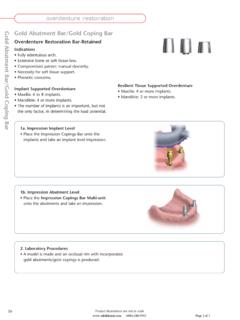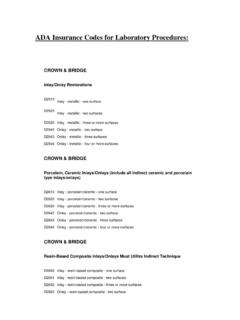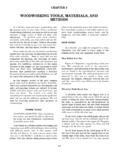Transcription of What is Valplast - Udell Dental Lab
1 Valplast FAQ: what is Valplast ? Valplast is a flexible denture base resin which is ideal for partial dentures. The resin is a biocompatible nylon thermoplastic with unique physical and esthetic properties. Valplast allows a patient s natural tissue tone to appear through the material, it s available in 3 shades, ask Udell for shade chips. It is guaranteed for life against breakage Valplast has been used to make partials since 1954. When should Valplast be used? Use whenever you are considering a removable partial denture for your patient. Valplast provides a fully functional, yet esthetically superior partial . The practical invisibility of Valplast makes it ideal for cases when your patient prefers not to go into a fixed restoration or implant, but still wants an esthetic restoration. Patients who ve worn both cast frame partials and Valplast say Valplast feels more natural in the mouth, is more comfortable because of the thinness and light weight, and gives them more confidence when eating and smiling because of the excellent retention and esthetics.
2 Patients with generally healthy mouths can expect many years of use from their Valplast partials (with many cases in use for over 15 years without modification). Is Valplast stable in the mouth? Valplast partials are stable in the mouth; however some instances demand a cast framework. When that is the case, we will give you a call and recommend you use a Vitallium 2000 framework (no clasps) processed with Valplast . Insurance codes: Maxillary flexible partial denture D5225 Mandibular flexible partial denture D5226 Patient care recommendations: A Valplast partial should be soaked overnight at least 3 nights a week in Val-Clean denture cleaner or daily for about 10-15 minutes and rinsed with water before putting in mouth. Do not use a brush to clean the appliance. Over time brushing dulls the shine; also don t use effervesant cleaners or cleaners containing peroxide or bleach.
3 If Val-Clean is not readily available, Stain-Away is available at Walgreens. To order: Valplast Support Services handles Val-Clean sales 1-800-843-2861 Ordering by mail: Valplast Support Services c/o Valplast International Corp., 34-30 31st Street, Long Island City, NY 11106. Order from website: A credit card is accepted with phone orders or a check with mail orders. As a dentist, you can buy Val-Clean from your Dental dealer or Valplast Support Services and sell it as a retail product to your patients. what marketing materials are available? Patient demonstration models are the best way to demonstrate the flexibility and esthetics of Valplast , there are many designs available and we sell them at our cost, patient literature is available at no cost. Occasionally we have reject partials available at no cost. Call Amy to request any item. Who do I call with questions? Jeff has undergone training on the Valplast unit and he and another certified technician make all the cases.
4 Don Udell or Amy Chapman can also help you, and if you have any questions about whether Valplast will work for a particular case, just send us the models and request a call. 3361 Gorham Avenue St. Louis Park, Minnesota 55426 800-248-9943 952-926-9266 CHAIRSIDE INSTRUCTIONS: Valplast preparation techniques: Valplast uses the Retento-Grip tissue-bearing techniques for retention. No tooth or tissue preparation is needed. Take an alginate impression, (gently stirred from the bottom of the container to the top to first redistribute the heavier elements that control shrinkage in the set material). Pour the model promptly, no special stone is necessary, but don t use plaster. Also send us the opposing model and wax bite. At the laboratory: Udell Dental Laboratory is an authorized Valplast processing laboratory that will design the case on the master model, placing all necessary relief and blocking-out in wax. We ll duplicate the model and wax the case on the duplicate model.
5 After investing and washing out, the teeth are prepared for mechanical retention. Valplast resin is injected into a closed flask. After the case is deflasked, it is finished and fit on the master model, polished, and delivered with a warranty slip, 1 package of Val-Clean and patient care instructions. Insertion techniques: Immediately prior to inserting the appliance in patient s mouth, immerse it in very hot tap water. Leave it in the water for about 1 minute, remove and allow to cool to the point where it will be tolerated by the patient. Gently insert in mouth. The hot water permits a smooth initial insertion and good adaptation with the natural tissues in the mouth. If the patient senses any discomfort because of tightness of a clasp, the clasp may be loosened slightly by immersing that area of the partial in hot water and bending the clasp outward. If a clasp requires tightening, bend clasp inward. Note: if the patient feels irritation around the buccal clasp, consider that the case may not be fully seated.
6 This may be due to an obstruction on the lingual side of the case, even though the patient senses tightness on the buccal side. Examine the fit of the case in the mouth, and possibly relieve areas that fall into lingual undercuts in order to relieve stress that is felt in the buccal areas. If any reduction is needed due to persistent irritation, the resin must be handled differently than acrylic. We recommend the use of green mounted stones ( Valplast Green Mounted Point #202G013, like those used for porcelain adjustment, one was sent with your first Valplast case). Use a delicate touch with the handpiece rotating between 20,000 and 25,000 rpm in rapid repetitive motion. The resin will melt if there is prolonged contact with a bur or wheel, so continuously move the instrument over the surface. We also recommend the use of Komet USA s carbide cutters. H251 GSQ-060, H79 GSQ-040, H351 GSQ-060. They are especially efficient due to their unique cross cut design and limited vertical blades that allow for material removal.
7 They are optimally operated at 15000 rpm with a light touch, let the instrument do the work. We sell adjustment kits, call for information. If there are any threads remaining, additional finishing can be completed with the 9485M abrasive buff from Komet USA. This product resembles a Scotch-Brite pad on a mandrel and effectively reduces any residual threads or strands. The surface may be repolished using 5 steps: 1) pumice (Acrylux 150) applied with a wet rag wheel 2) brown Tripoli, applied with a dry rag wheel while frequently dipping the appliance in water to maintain a cool temperature 3) brush off with B-20 brush 4) Mirror-shine high polish, applied gently with a dry rag wheel 5) brush off. Typical laboratory polishing time is 5-7 minutes per case from finish to polish. Preparation for adding a tooth to a Valplast partial : First it is essential to remove all pastes or adhesives from the tissue surface of the appliance. Take an alginate impression over the appliance that is fully seated in the mouth.
8 Make sure the appliance is positioned correctly in the impression and promptly pour the model and send to us, we will use an injection technique to make additions. Preparation for a reline: Take a rubber-based impression under the appliance in a closed-mouth condition. Take an alginate impression over the appliance that is fully seated in the mouth. Promptly pour the model and send to the lab. We will register the position of the teeth with a plaster matrix and remove the base. A new base will be waxed-up and reprocessed using the existing teeth. When inserting a reline, follow the same steps you do for a new denture. Valplast turnaround: set-up = 2 days, finish = 3 days, repairs/relines = 2 days. You do not have to have a wax-try in appointment although we recommend it. 12/30/2008








